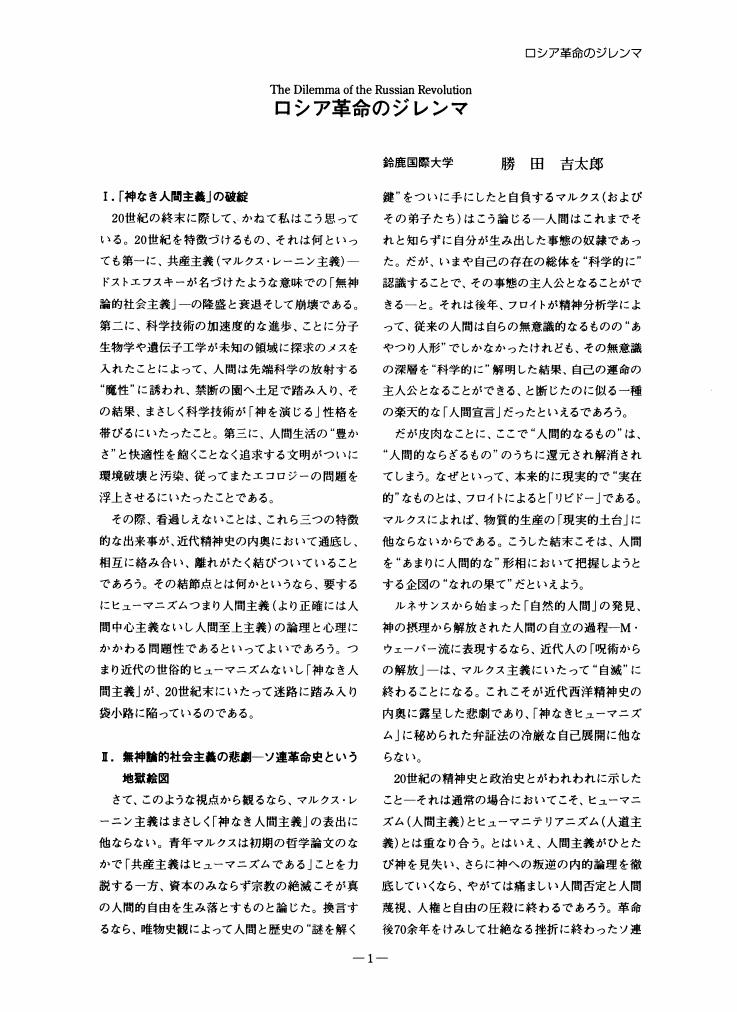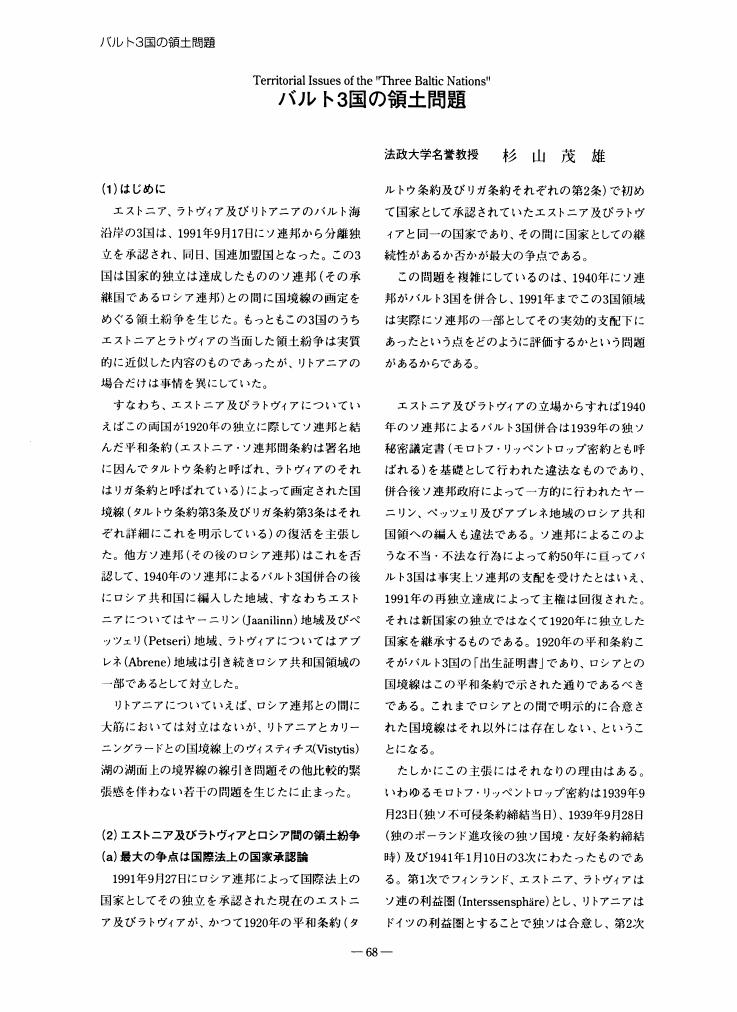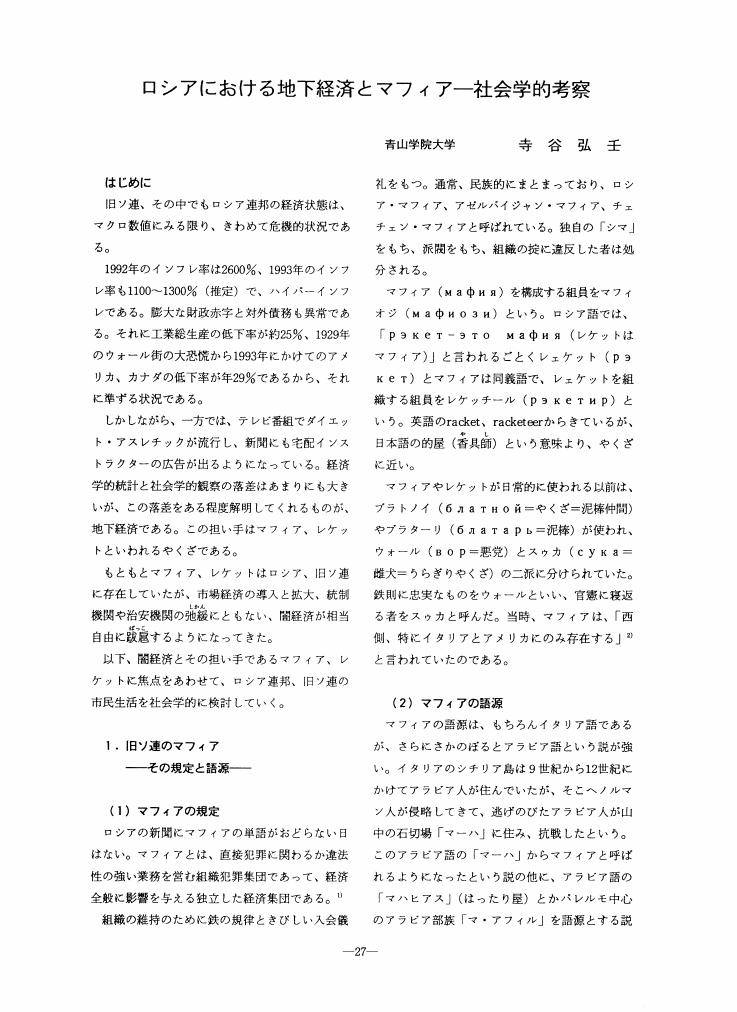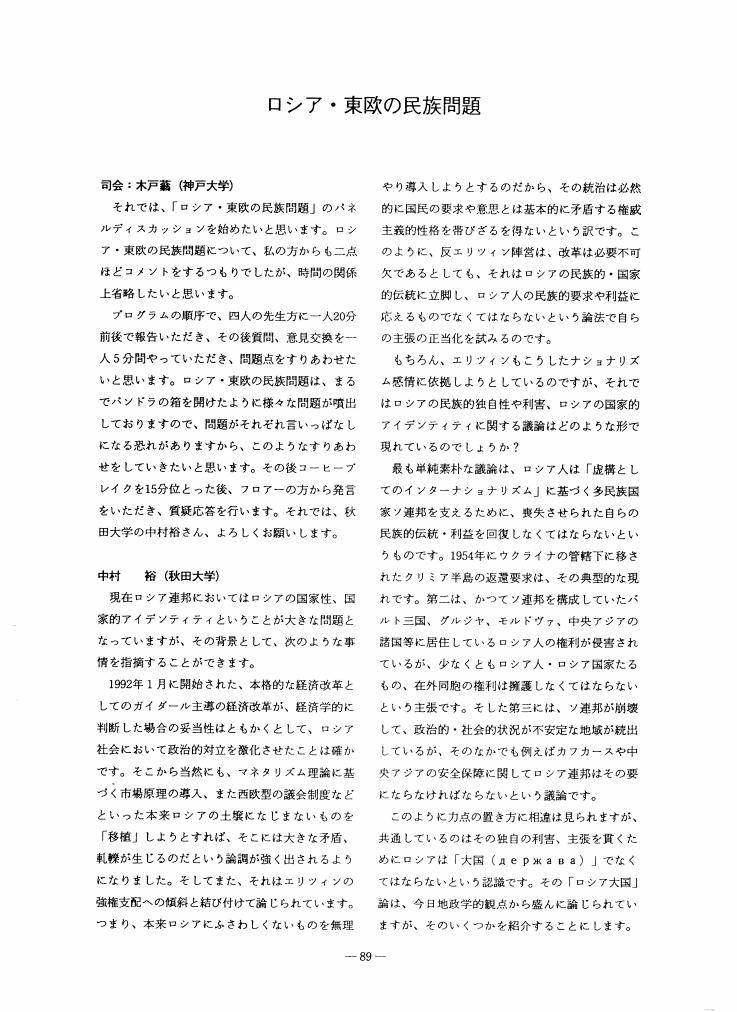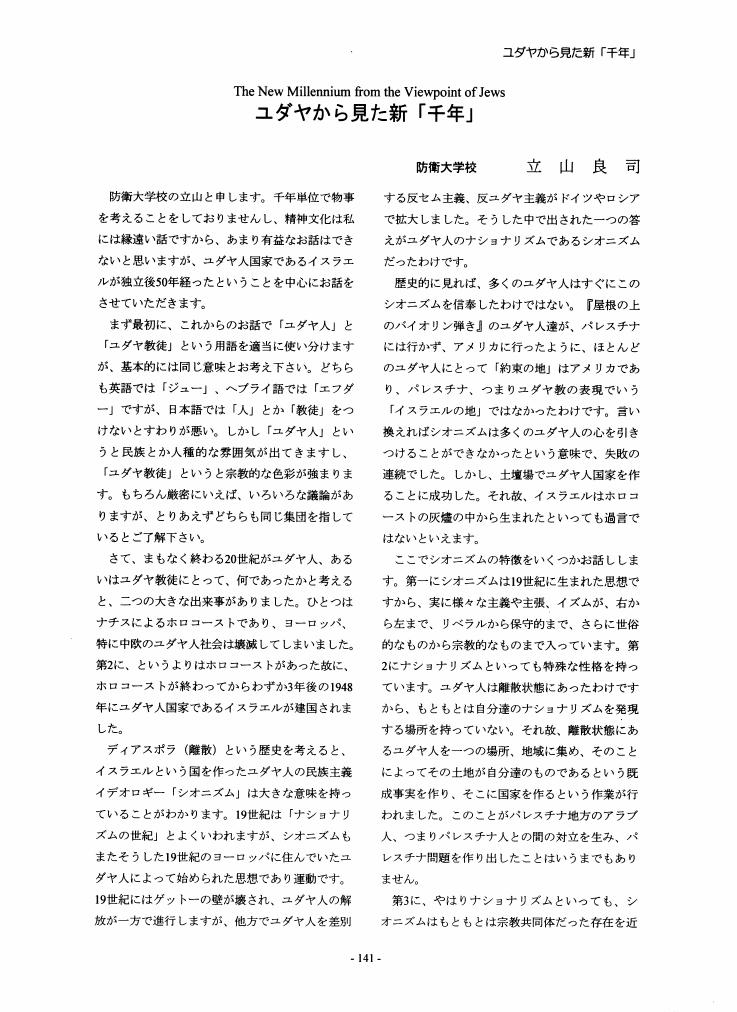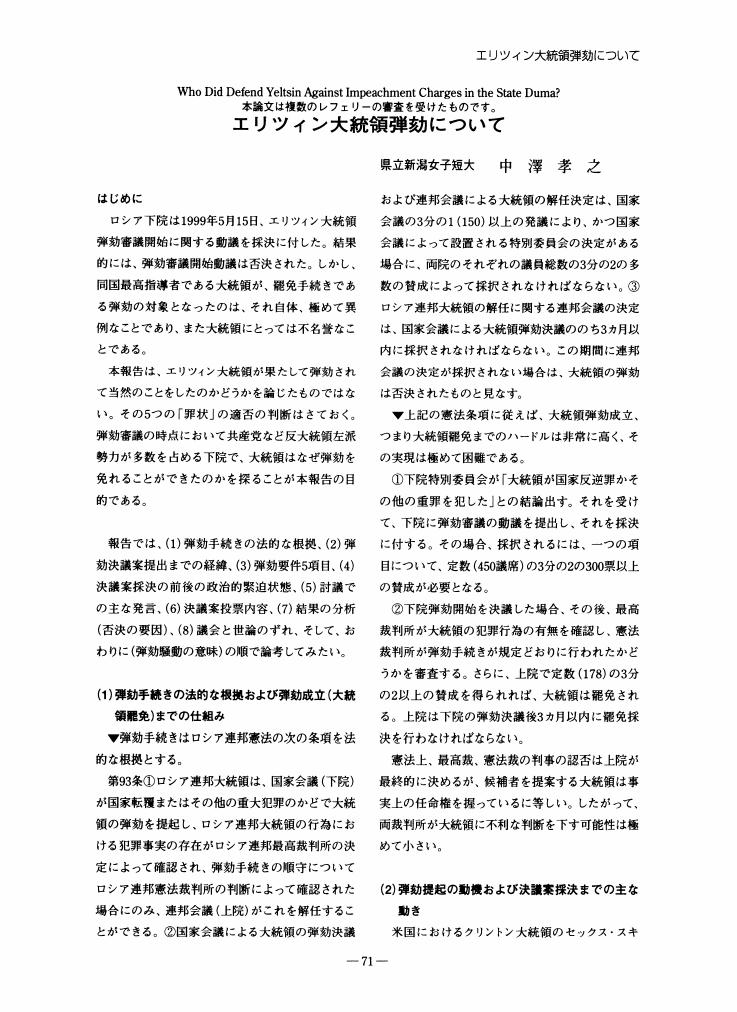39 0 0 0 OA レーニンの民族問題についての思想と現状
- 著者
- 村井 淳
- 出版者
- ロシア・東欧学会
- 雑誌
- ロシア・東欧学会年報 (ISSN:21854645)
- 巻号頁・発行日
- vol.1993, no.22, pp.68-75, 1993 (Released:2010-05-31)
- 参考文献数
- 35
24 0 0 0 OA 国際法から見た日本人捕虜のシベリア抑留
- 著者
- 白井 久也
- 出版者
- ロシア・東欧学会
- 雑誌
- ロシア・東欧学会年報 (ISSN:21854645)
- 巻号頁・発行日
- vol.1994, no.23, pp.33-42, 1994 (Released:2010-05-31)
- 著者
- 杉山 秀子
- 出版者
- ロシア・東欧学会
- 雑誌
- ロシア・東欧学会年報 (ISSN:21854645)
- 巻号頁・発行日
- vol.1995, no.24, pp.118-125, 1995 (Released:2010-05-31)
- 参考文献数
- 8
4 0 0 0 OA コソヴォ問題に対する大国の介入 ―その経緯と特徴―
- 著者
- 三井 光夫
- 出版者
- ロシア・東欧学会
- 雑誌
- ロシア・東欧学会年報 (ISSN:21854645)
- 巻号頁・発行日
- vol.1999, no.28, pp.126-135, 1999 (Released:2010-05-31)
- 参考文献数
- 40
4 0 0 0 OA ロシア革命のジレンマ
- 著者
- 勝田 吉太郎
- 出版者
- ロシア・東欧学会
- 雑誌
- ロシア・東欧学会年報 (ISSN:21854645)
- 巻号頁・発行日
- vol.1999, no.28, pp.1-4, 1999 (Released:2010-05-31)
4 0 0 0 OA スターリンの民族問題についての思想と政策
- 著者
- 村井 淳
- 出版者
- ロシア・東欧学会
- 雑誌
- ロシア・東欧学会年報 (ISSN:21854645)
- 巻号頁・発行日
- vol.1994, no.23, pp.76-84, 1994 (Released:2010-05-31)
- 参考文献数
- 44
3 0 0 0 OA バルト3国の領土問題
- 著者
- 杉山 茂雄
- 出版者
- ロシア・東欧学会
- 雑誌
- ロシア・東欧学会年報 (ISSN:21854645)
- 巻号頁・発行日
- vol.1998, no.27, pp.68-73, 1998 (Released:2010-05-31)
3 0 0 0 OA ロシア人女性の家庭と労働に関する意識 ―サンクト・ペテルブルグでの調査を中心に―
- 著者
- 五十嵐 徳子
- 出版者
- ロシア・東欧学会
- 雑誌
- ロシア・東欧学会年報 (ISSN:21854645)
- 巻号頁・発行日
- vol.1997, no.26, pp.110-119, 1997 (Released:2010-05-31)
- 参考文献数
- 24
- 著者
- 松里 公孝
- 出版者
- ロシア・東欧学会
- 雑誌
- ロシア・東欧学会年報 (ISSN:21854645)
- 巻号頁・発行日
- vol.2000, no.29, pp.49-71, 2000 (Released:2010-10-27)
- 参考文献数
- 30
- 被引用文献数
- 1 1
Kuchma's “cassette tape scandal” in 2000-2001 exemplified the patrimonial phenomena that has become prevalent in post-communist Ukrainian politics. However, this patrimonial tendency has not been combined with classic authoritarianism but machine politics (or ‘caciquismo’), in which election votes play a decisive role in intra-elite struggles for power. As a rule, caciquismo is based on independent meso-elites which function as mobilizers of votes and also as political brokers between localities and the center. Ukraine is not an exception, although in this country the meso-elites independence is masked by a constitutional unitarism and an appointment system of regional and ‘raion’ chief executives. Therefore, we need to pay attention to patrimony building at the regional level, which provides a social basis for strong regional electoral machines. I sampled four regions which contributed to Kuchma's victory in the 1999 presidential elections : Odesa, Transcarpathia, Donetsk and Dnipropetrovsk. Remarkably, despite previously sympathizing with the opposition, the electorate in these regions changed their political inclinations in the few years leading up to the 1999 elections. Along with the common tendency of electoral machines being based on the regional patrimony, a contrast was found with the extent to which this machine/patrimony had been legalized. This is the problem of regional party building. The development of a regional party system is determined by two factors :(1) intra-elite competition and,(2) interactions between party system levels. Regarding the latter, if infra-regional issues are converted into national political issues in a region, we can say that the interactions between party system levels have been activated. In 1994-98, Odesa Region experienced harsh infra-elite competition between its governor and Odesa mayor, but even in 1998 this conflict remained infra-regional (Kyiv only intervened sporadically). Donetsk and Dnipropetrovsk politics were forcibly nationalized in 1996 and after 1997 respectively, since the top leaders of these regions became rivals for Kyiv politicians (Donetsk governor Shcherban versus the then prime minister Lazarenko ; and the Dnipropetrovsk Soviet chair Lazarenko versus President Kuchma). Nevertheless, Kyiv could not divide these regions' elites. In Transcarpathia conflicts between the governor and the mayor of the regional capital Uzhhorod became nationalized in 1997-98 because the governor allied with the Medvedchuk faction of the Social Democratic Party of Ukraine (United), a typical legalized clan organization from Kyiv. In other words, only in Transcarpathia were the two conditions fully met and thus a formal party system was able to develop.
3 0 0 0 OA プーチン政権とロシア国内情勢
- 著者
- 上野 俊彦
- 出版者
- ロシア・東欧学会
- 雑誌
- ロシア・東欧学会年報 (ISSN:21854645)
- 巻号頁・発行日
- vol.2000, no.29, pp.1-11, 2000 (Released:2010-05-31)
- 参考文献数
- 52
The author analyzes President Putin's career in the first chapter of this paper. The analysis shows that President Putin has two different backgrounds. One of them - that he was with the Soviet intelligence organ, KGB - is well known. The other is that he used to be part of the economic bureaucracy of St. Petersburg. These two disparate backgrounds are a sign ficant part of Putin's identity. Indeed, most of the executives in the President's office, as well as the Cabinet members andplenipotentiary representatives of federative regionsthat President Putin appointed, have careers similar to Putin's. This is a defining characteristic of the Putin administration.Furthermore, the author points out that one of the important features of Putin's political style is that he manipulates political, national and traditional symbols or images. One example is that at the time of the presidential election he emphasized his image of“a powerful leader”along the lines of Peter the Great, Alexander I, Stalin, and so on. Even after his inauguration as President this manipulation of symbols has continued. For example, he has enacted laws concerning the national flag, the national anthem and the national crest, which are legacies not only of the tradition of Imperial Russia but also of the Soviet Union. With such symbols, President Putin evokes nationalistic and patriotic enthusiasm among people and he has succeeded in mobilizing the support of the people.In the second chapter of the paper, President Putin's regional policy based on a revival of“a powerful state”is discussed. His regional policy is, in short, the strengthening of centralization or the vertical administrative system within the federal state. He demands that local legislation conform to the federal constitution and laws. Moreover, he has changed the procedures for forming the Upper House and has begun to weaken the authority of the Upper House. He has also tried to reduce the governors' authority. Moreover, plenipotentiary representatives of federative regionshave been sent out in order to strengthen central control over regions. President Putin is seeking to build a“strong Russia”through these regional policies.
3 0 0 0 OA 極右団体「ロシア民族統一」の思想 ―アレクサンドル・バルカショフの言説を中心に―
- 著者
- 宮川 真一
- 出版者
- ロシア・東欧学会
- 雑誌
- ロシア・東欧学会年報 (ISSN:21854645)
- 巻号頁・発行日
- vol.1999, no.28, pp.92-99, 1999 (Released:2010-05-31)
- 参考文献数
- 67
3 0 0 0 OA NATO拡大とロシアの対応
- 著者
- 角田 安正
- 出版者
- ロシア・東欧学会
- 雑誌
- ロシア・東欧学会年報 (ISSN:21854645)
- 巻号頁・発行日
- vol.1998, no.27, pp.1-10, 1998 (Released:2010-05-31)
- 参考文献数
- 37
3 0 0 0 OA ロシア正教会の復活と諸問題
- 著者
- 阿部 軍治
- 出版者
- ロシア・東欧学会
- 雑誌
- ロシア・東欧学会年報 (ISSN:21854645)
- 巻号頁・発行日
- vol.1995, no.24, pp.103-110, 1995 (Released:2010-05-31)
- 参考文献数
- 9
3 0 0 0 OA ロシア (旧ソ連) のドイツ人―その歴史的運命について―
- 著者
- 福住 誠
- 出版者
- ロシア・東欧学会
- 雑誌
- ロシア・東欧学会年報 (ISSN:21854645)
- 巻号頁・発行日
- vol.1994, no.23, pp.92-98, 1994 (Released:2010-05-31)
- 参考文献数
- 50
3 0 0 0 OA ロシア自由主義の歴史と意味
- 著者
- 鈴木 肇
- 出版者
- ロシア・東欧学会
- 雑誌
- ロシア・東欧学会年報 (ISSN:21854645)
- 巻号頁・発行日
- vol.1993, no.22, pp.60-67, 1993 (Released:2010-05-31)
- 参考文献数
- 14
2 0 0 0 OA ロシアにおける地下経済とマフィアー社会学的考察
- 著者
- 寺谷 弘壬
- 出版者
- ロシア・東欧学会
- 雑誌
- ロシア・東欧学会年報 (ISSN:21854645)
- 巻号頁・発行日
- vol.1993, no.22, pp.27-38, 1993 (Released:2010-05-31)
- 参考文献数
- 33
2 0 0 0 OA ロシア・東欧の民族問題
- 出版者
- ロシア・東欧学会
- 雑誌
- ロシア・東欧学会年報 (ISSN:21854645)
- 巻号頁・発行日
- vol.1993, no.22, pp.89-105, 1993 (Released:2010-05-31)
2 0 0 0 OA ユダヤから見た新「千年」
- 著者
- 立山 良司
- 出版者
- ロシア・東欧学会
- 雑誌
- ロシア・東欧学会年報 (ISSN:21854645)
- 巻号頁・発行日
- vol.2000, no.29, pp.141-143, 2000 (Released:2010-05-31)
2 0 0 0 OA ロシアにおけるオリガルヒヤについて―その形成期における権力との癒着を中心に―
- 著者
- 中澤 孝之
- 出版者
- ロシア・東欧学会
- 雑誌
- ロシア・東欧学会年報 (ISSN:21854645)
- 巻号頁・発行日
- vol.2000, no.29, pp.12-21, 2000 (Released:2010-05-31)
- 参考文献数
- 10
This report was written with the intention which tried to clarify the realities of the oligarchies (the financial cliques)in Russia. The Russian economic oligarchy research has just started in Japan. Even in Russia, so far it seems to be insufficient. A real research is the future task. It can be said that economic oligarchy exactly symbolizes the Yeltsin age by the phenomenon which appears by the process of conversion to capitalism in Russia during about past ten years. The Russian oligarchies skillfully accumulated the capital in the first stage of Russian capitalism with economic confusion and incompleteness of the law. That is, the monopoly (oligopoly) of wealth in Russia of the present age was achieved by small number of oligarchies. The numbers of the groups were from 7 to 10 only. Privatization of government-owned properties was the splendid chance for the oligarchies. They approached the senior officials of the Yeltsin regime and build a special intimate relation with a Yeltsin family (“semiya” in Russian) to win by the public bidding for privatization. It was adhesion with the regime, by which the oligarchies have increased the property. On of the model is Berezovsky's case. The tycoon was often called even the safe keeper of the “semiya”. First of all, I look back to the time when small number of Russian financial capitalists gained power and enumerate the groups concretely. In addition, I point out their shady relationships with the regime while introducing the examples of their action behind the scene of the process of the war between banks and privatization of the government-run oil companies. Secondly, I verify when Russian words “oligarxhy” or “oligarxhiya” came to appear to the mass communication in Russia. Thirdly, I enumerate names of the oligarchies' groups and each representative's names, and classify them into some categories according to some current reports. Moreover, I elucidate the reason why they became rich after the Soviet Union was dismantled. Finally, I somewhat refer the movement of the old and new oligarchies in the Putin's regime.
2 0 0 0 OA エリツィン大統領弾劾について
- 著者
- 中澤 孝之
- 出版者
- ロシア・東欧学会
- 雑誌
- ロシア・東欧学会年報 (ISSN:21854645)
- 巻号頁・発行日
- vol.1999, no.28, pp.71-82, 1999 (Released:2010-05-31)




